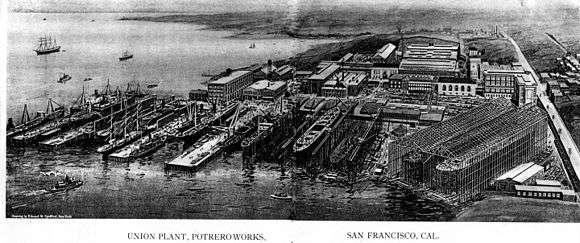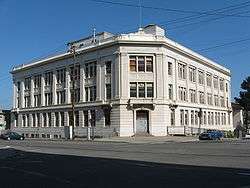Union Iron Works

Union Iron Works, located in San Francisco, California, on the southeast waterfront, was a central business within the large industrial zone of Potrero Point, for four decades at the end of the nineteenth and beginning of the twentieth centuries.
History
The Donahue Brothers Peter and James, Irish immigrants, founded Union Iron Works in the south of Market area of San Francisco in 1849. After years as the premiere producer of mining, railroad, agricultural and locomotive[1] machinery in California, Union Iron Works, led by I.M. Scott, entered the ship building business and relocated to Potrero Point where its shipyards still exist, making the site on the north side of the Potrero the longest running privately owned shipyard in the United States. After Bethlehem Shipbuilding Corporation bought the works in 1905, the consolidated company came to include the Alameda Works Shipyard, located across the San Francisco Bay in Alameda and the Hunter's Point shipyard to the south.

In 1885, the Union Iron Works launched the first steel hulled ship on the west coast, the Arago, built with steel from the Pacific Rolling Mills. In 1886, UIW was awarded a $1,000,000 contract to build a Naval cruiser, the Charleston, which they completed in eighteen months. From the completion of the Arago in 1884 to 1902, UIW built seventy-five marine vessels, including two of the most famous vessels of the Spanish–American War, the Olympia and the Oregon.
An 1892 description of the yards stated that between 1200 and 1500 men were employed and the yearly gross revenue was between $2,000,000 and $4,000,000. By the turn of the century, the shipyard had expanded in area and employment had more than doubled to 3,500. These industrial facilities used five types of power, distributed throughout; electricity, compressed air, steam, hydraulic and coal or gas fire. Union Iron works built a number of ships for the United States Navy. These ships include the USS Oregon laid down in 1891, and Adder-class submarines Grampus and Pike which were launched in 1902 and 1903, respectively. The latter two were subcontracted from the Holland Torpedo Boat Company, and were the first submarines built on the West Coast.
In 1902, the Union Iron Works was absorbed into a combine called the United States Shipbuilding Company and was mired in three years of litigation. In 1905, the entire 40-acre (160,000 m2) shipyard was purchased by Bethlehem Shipbuilding Corporation for one million dollars. Charles M. Schwab stood on the steps of the UIW office building on 20th Street during the auction. At this point, he was the only bidder. Schwab was widely believed to have engineered the demise of the U.S. Shipbuilding Corporation in order to gain control of the industry. Whether or not that was true, he certainly benefited from the collapse of the US Shipbuilding combine.

At the time of the 1906 San Francisco earthquake, the coastal passenger liner Columbia of the San Francisco and Portland Steamship Company had been undergoing a refit at the yard's hydraulic drydock. The earthquake caused the iron hulled Columbia to shift off her supports and roll onto the drydock on her starboard side. This rendered the drydock, a key feature of the yard, damaged beyond economic repair. The Columbia on the other hand, despite being partially flooded and damaged, was repaired and returned to service in January 1907.[2][3] In 1908, Bethlehem Shipbuilding Corporation bought the Hunters Point, San Francisco, California drydocks. In the pre-World War I era, Union Iron Works built several navy ships that became internationally famous due to the Spanish–American War; Commodore Dewey's flagship the Olympia. After 1905, the shipyard operated as part of Bethlehem Steel, and produced both warships and merchant ships.

Locomotives built
The named locomotives built by Union Iron Works were:[1]
- "California" for the San Francisco and San Jose Railroad
- "Atlantic" for the San Francisco and San Jose Railroad
- "A. A. Sargent" for the Central Pacific Railroad
- "Mt. Diablo" for the Pittsburg Railroad
- "Boston" for the Pittsburg Railroad
- "Union" for the San Francisco and San Jose Railroad
- "Sampson" for the Pittsburg Railroad
- "D. O. Mills" (named after Darius Ogden Mills) for the Black Diamond Coal Mining Railroad (also known as the "Black Diamond Railroad")
- "Calistoga" for the California Pacific Railroad
- "Lyon" for the Virginia and Truckee Railroad
- "Ormsby" for the Virginia and Truckee Railroad
- "Storey" for the Virginia and Truckee Railroad
- "J. G. Downey" (named for John G. Downey, nineteenth-century Governor of California) for the San Francisco and North Pacific Railroad
- "W. C. Ralston" (named for William Chapman Ralston) for the San Francisco and North Pacific Railroad
- "Geyser" for the San Francisco and North Pacific Railroad
- "Santa Rosa" for the San Francisco and North Pacific Railroad
- "John D. Hall" for the Battle Mountain and Lewis Railroad
- "S. H. Harmon" for the Gualala Railroad
- "Starr Grove" for the Battle Mountain and Lewis Railroad
- "F. Camacho" for the Acajutla and Sonsonate Railroad
- "Ukiah" for the San Francisco and North Pacific Railroad
Ships/Ferries built
Some of the ships and ferries built by Union Iron Works include:
- El Primero launched in 1893
- USS Oregon (BB-3) launched in 1893
- USS Wisconsin (BB-9) launched in 1898
- Berkeley, 1898 Southern Pacific Railroad ferry, constructed simultaneously with the USS Wisconsin in an adjacent drydock. First complete ferry built by Union Iron Works
- San Pablo, Atchison, Topeka & Santa Fe Railroad passenger ferry. 1899. Sold for scrap in 1937. Hull became first fish reduction plant on San Pablo Bay
- Tamalpais, 1900 Northwest Railroad Passenger Ferry. Burned for scrap 1947
- USS Ohio (BB-12) launched in 1901
- USS Monterey (BM-6) launched in 1891
- USS Wyoming (BM-10) launched in 1900
- USS Wheeling (PG-14) launched in 1897
- USS Marietta (PG-15) launched in 1897
- USS Charleston (C-2) launched in 1888
- USS San Francisco (C-5) launched 26 October 1889
- USS Olympia (C-6) launched in 1892. Admiral Dewey's flagship at the Battle of Manila Bay
- USS Tacoma (CL-20) a Denver class cruiser launched in 1903
- USS Milwaukee (C-21) a St. Louis class cruiser launched in 1904
- The four Atlanta class cruisers; USS Oakland, USS Reno, USS Flint, and USS Tucson, for the United States Navy in 1945 and 1946
- Japanese cruiser Chitose launched in 1898
- Adder class submarines USS Grampus and USS Pike for the United States Navy in 1902 and 1903
- San Pedro, 1910 Atchison Topeka & Santa Fe Railroad Passenger Ferry. Renamed "Treasure Island" when it joined Key System in 1938
- Napa Valley, 1910 Monticello Steamship Company passenger ferry. Sold and resold until scrapped on Portland, OR in 1956
- Tanker SS Acme for the United States Shipping Board in 1916
- Bainbridge class destroyers USS Paul Jones (DD-10), USS Perry (DD-11) and USS Preble (DD-12) for the United States Navy Between 1900 and 1902
- S.S. Fred W. Weller Steel tanker
- S.S. Invincible 1918 Freighter
- S.S. Courageous 1918 Steel cargo vessel
- 28 Wickes class destroyers for the United States Navy between 1917 and 1919
- 39 Clemson class destroyers for the United States Navy between 1918 and 1921
- San Mateo, 1921 Six-Minute Ferry Co. auto ferry. Short-lived ferry company funded by "Sunny Jim" James Rolph Went to Puget Sound in 1940
- S.S. Victorious 1921 Steel cargo vessel
- Shasta, 1922 Six-Minute Ferry Co. Short-lived ferry company funded by "Sunny Jim" James Rolph. Acquired By Southern Pacific while under construction. Went to Puget Sound in 1940 Later to Willamette River Portland, OR, and turned into restaurant.
- Yosemite, 1922 Six-Minute Ferry Co. auto ferry. Short-lived ferry company funded by "Sunny Jim" James Rolph. Acquired By Southern Pacific while under construction. Later to Rio de la Plata and renamed "Argentina"
- El Paso, 1924 Richmond-San Francisco Transportation Co. auto ferry. Retired 1956
- New Orleans, 1924 Richmond-San Francisco Transportation Co. auto ferry. Renamed Russian River in 1938. Retired 1956
- Klamath, 1924 Richmond-San Francisco Transportation Co. auto ferry. Retired 1956. Served as offices at Pier 5, 1968 -1986 then sold and moved to Stockton.
- Fresno, 1926 Southern Pacific Railroad auto ferry. Went to Puget Sound as "Willapa" in 1937
- Stockton, 1926 Southern Pacific Railroad auto ferry. Went to Puget Sound as "Kuckitat" in 1937
- Mendocino, 1927 Southern Pacific Railroad auto ferry. Went to Puget Sound as "Nisqually" in 1937
- Gridley class destroyers USS McCall and USS Maury for the United States Navy in 1937 and 1938
- 9 Benson class destroyers for the United States Navy in 1941 and 1942
- 12 Buckley class destroyer escorts for the United States Navy in 1943 and 1944[4]
- 16 Fletcher class destroyers for the United States Navy in 1942 and 1943
- 6 Allen M. Sumner class destroyers for the United States Navy in 1944 and 1945
- Gearing class destroyers USS William C. Lawe, USS Lloyd Thomas and USS Keppler for the United States Navy in 1945 and 1946
Ships reconstructed by the Union Iron Works include:
- SS Columbia - Refitted unsuccessfully due to heavy damage caused by the 1906 San Francisco earthquake. Refit and repairs completed elsewhere.[3]
See also
- Alameda Works Shipyard
- Rosie the Riveter/World War II Home Front National Historical Park
- Potrero Point
- Pier 70, San Francisco
- San Francisco Maritime National Historical Park
References
- 1 2 Gilbert H. Kneiss, Locomotives of The Union Iron Works, Railway and Locomotive Historical Society Bulletin No. 68, November, 1946.
- ↑ "Pier 70: History". Pier 70 San Francisco - Historic Shipyard at Potrero Point (pier70sf.org). Retrieved 21 August 2013.
- 1 2 Belyk, Robert C. Great Shipwrecks of the Pacific Coast. New York: Wiley, 2001. Print.ISBN 0-471-38420-8
- ↑ "Archived copy". Archived from the original on April 2, 2015. Retrieved March 18, 2015.
- Bethlehem Steel Company Shipbuilding Division. A century of progress, 1849-1949: San Francisco Yard. San Francisco, 1949
Coordinates: 37°45′38.68″N 122°23′4.01″W / 37.7607444°N 122.3844472°W
- Mains'l Haul - Journal of Pacific Maritime History - Fall 1998
External links
| Wikimedia Commons has media related to Union Iron Works. |
- Images of America: Black Diamond Mines Regional Preserve (Google Books "preview" version; contains some locomotive photographs)
- Museum of San Francisco
- Current photos and history
- A guide to the Irving Murray Scott Jr. business papers and plans, 1881-1943
- Finding Aid to the Bethlehem Steel Corporation. Shipbuilding Division Photographs, circa 1900-1945
- A guide to the John T. Scott photograph collection, 1856-1923
- A guide to the John T. Scott photograph collection, 1900-1916
- A guide to the John Thomas Scott business papers and plans, 1888-1921